
Getty Images, Hulton Archive
By: NPR
Jeff Hellmer is an accomplished jazz pianist who has taught music at the University of Texas at Austin for 27 years. He thinks of himself as more than a teacher, though: “What I would like to do with my teaching is be an ambassador for jazz.”
This past spring, in what’s become an increasingly common move, he brought his ambassadorship to a wider audience. He turned his popular introductory course, Jazz Appreciation, into a free 10-week online course.
It’s open to anyone on through a company called edX, and 19,000 people signed up.
Online college is no longer the future. It’s here. According to the Sloan Consortium, more than one-third of all U.S. college students now take at least one course online for credit. That’s 7 million students last year alone. Meanwhile, on platforms like edX (over 2 million users) and Coursera (over 8 million users), people from every country in the world are taking free versions of college courses.
And Starbucks just announced that it will offer over 100,000 employees the chance to take college classes online from Arizona State University.
The news from Starbucks, amid this dramatic expansion of online learning, has reignited a long-running debate about the quality of what’s being offered.
In other words, can 19,000 students, watching a video of Jeff Hellmer on their computer screens, ever hope to learn as much – or learn as well – as the students who’ve sat in a classroom right in front of him for all those years?
To answer that, we need to define and measure “quality” in online education. Which is tricky, because we don’t have a great definition of quality in face-to-face education.
Fortunes—not to mention the education that millions of students will receive —ride in the balance.
The Problem
There’s reason to be cautious.
A meta-analysis by the U.S. Department of Education in 2010 showed that students performed modestly better in courses with some online component.
However, a more recent study from Columbia University, focusing specifically on community college students, shows that college students are more likely to withdraw from online courses, that they score lower in these courses when they do finish, and that those who begin college with online courses are less likely to persist and complete their degrees.
The study also found that online courses tend to widen the achievement gap: African-Americans, and those with lower previous grades, do worse in an online environment.
The Columbia researchers, as well as other critics, argue that the reason students so often fail in these classes is because of the way the instruction is designed.
Most online courses, including Massive Open Online Courses, or MOOCs, consist of video snippets of lectures, readings, and multiple-choice quizzes. There’s usually some kind of online forum or discussion page for students to talk over the concepts presented in the course.
Basically, it’s copying the traditional classroom lecture format into the online realm.
The main strength of this approach as that it can be done almost free. That’s exactly what gets people so excited about online education in general, and MOOCs in particular.
Anant Agarwal, the founder of edX, likewise, told me in a recent interview that giving millions around the world of people access to higher education is a key goal of the initiative, which is backed by MIT and Harvard. He makes a comparison to basic infrastructure. “We are building free broad gauge railroad around the world,” he says. “You can think of the content as the carriages.”
The metaphor—comparing the distribution of knowledge with the distribution of, say, coal or sugar—is one that troubles many critics of educational technology.
“Is education content delivery? Is it the same as putting resources online?” asks Audrey Watters, an author and blogger. “We’re starting to frame teaching and learning in terms of language we use to talk about the web and media: ‘content delivery platforms’ and ‘learning management systems.’ “
Instead of the oft-maligned “factory model” of education, she says, what you end up with instead is a “cubicle model”—one person with a laptop, shoveling in information.
Adaptive Learning
There are attempts to use new technology to make online learning more interactive. Some of these efforts show promise – especially in the area of reaching remedial students.
At the University of Texas, Jeff Hellmer partnered with a company called Cerego to translate some of the material he covers in the jazz course into a set of what are often called “adaptive learning” items.
Andrew Smith Lewis, cofounder of Cerego, calls his company’s technology “flashcards on steroids.”
Hellmer created 180 items covering historical facts, technical elements of jazz music, and music clips where the student would have to listen and name the title, artist, and era.
For example, a picture of Art Blakely requires a student to identify the ‘Hard Bop,” era. Or they listen to a snippet of ‘Kind of Blue’ and must answer ‘Miles Davis.’ As you go through the set, the system is predicting how well you know each item, based on how many times you’ve seen it, how recently you’ve seen it, and how often you’ve seen it.
(Here is the full set if you want to test yourself).
Cerego uses an artificial intelligence algorithm, based in part on the science of memory, to decide which item to show you next, and when to show you the same item again. The goal is that you memorize them in an optimal amount of time. The program is also designed to get students to retain the information longer than with traditional methods. You have to identify each item correctly multiple times instead of just cramming to get it right one day on one quiz.
A central feature of adaptive learning is that it varies the presentation of content according to the user’s responses.
The secret sauce of this system? It’s kind of fun, like a video game.
“The mechanics of a successful game are designed to keep you in this band between boredom and frustration,” says Cerego’s Smith Lewis. “We see a nice uptick in engagement and completion.”
The thinking is that students are more likely to stick with Cerego-enhanced courses because it was a thrill to challenge themselves with the flashcard tool.
Millions of students from kindergarten through college are currently using adaptive learning software, both in online-only and blended settings.
Among the most popular are Pearson’s MyMathLab, with 10 million college students, Scholastic’s Math 180, Dreambox Learning, and Khan Academy. Math is the most common subject being taught this way, but the programs can cover any topic with a set of facts to be absorbed.
A leader in these efforts is Arizona State University, which has gone farther than any other large university to bake these concepts into online courses from the get-go.
The university has partnered with Pearson and a company called Knewton since 2011 on dozens of courses. ASU officials say they’ve had especially positive results with their developmental math courses—the exact same type of course that the Columbia University researchers found online students were doing worse in.
Bean-counting
”Quality” in online education is about more than enhancing content delivery or adding multimedia bells and whistles.
The technology makes it possible to measure student outcomes in unprecedented detail. This is affecting the way we think about quality in all of education.
There’s a wealth of data available, for example, from Jeff Hellmer’s Jazz Appreciation course.
Students on average memorized the basic facts in just 11 hours, using Cerego. And of the more than 20,000 who signed up initially, 2,370 actually passed. That’s a 12 percent pass rate—compared to the 5 percent typical for most MOOCs.
Two-thirds of those who finished did so with a grade over 90 percent. Three-fourths of students agreed that using Cerego’s adaptive learning tools helped them learn the material faster, which the company’s research shows is true in other subjects.
That level of data collection could enable schools to move beyond the traditional definition of quality in higher education, based on selectivity and scarcity. Historically, “top students” got into the most expensive colleges, and that made them “top schools.”
But most students attend public universities and community colleges that accept the vast majority of the students who apply. Therefore selectivity doesn’t apply broadly as a measure of quality. And so, colleges in this sector, with the enthusiastic support of the federal government, are developing new, data-driven measures of quality based on student outcomes, like transfer, graduation, and employment rates.
Arizona State University is a case in point. It’s a giant public institution with over 75,000 students, that accepts 90 percent of those who apply.
In recent years the university has become preoccupied with improving outcomes. Their six-year graduation rate is now at 58.7 percent, compared to a national average of 59 percent (but just 31 percent for open-admission schools like ASU). This is trending up: the number of degrees awarded has increased 60 percent since 2002.
In part, ASU is relying on technology, like an online advising system called eAdvisor, to improve student success. The system helps students navigate the university’s 290 majors and map out the courses they need to reach their goals. ASU Online launched in 2006. President Michael Crow’s vision is to grow online enrollment to 100,000 students. The recent deal with Starbucks is part of that effort.
On some key measures ASU’s current 10,000 online-only students seem to be doing worse than on-campus students: the 3-year graduation rate is just 36 percent (most online students come into the program with some college credits already, which is why they report three-year rates). This jibes with what we see in many online programs.
The Blend
In this drive to define – and achieve – “quality” in online education, as in traditional education, research points to one essential element: interaction with instructors.
It doesn’t have to be face to face. Video chats, phone calls, email and even text messages can all help students stay engaged and motivated. Group work and peer discussions are important too.
But instructor time remains the most expensive resource, and it’s often scarce and rationed, especially in the online realm.
Smith Lewis, along with other ed-tech people I talked to, framed the next generation of computer enhanced learning as a way to free up professors to do what they do best—not to replace them.
Professor Hellmer, for one, was so taken with the Cerego platform that he decided to incorporate it into his live, in-person classes, starting this summer. He sees it as a labor-saving device: the machine will handle the shoveling in of facts, while he does the cultivating of the students’ mental gardens.
“The part I’m looking forward to is spending more time discussing more complicated issues or higher-level thinking,” he said. “I’m hoping that Cerego is going to take care of that foundational learning more efficiently.”
He says the Cerego content will make up “about half” of the grade in the class. Instead of taking quizzes where they might just be guessing the right answer, students will have to study until they get a certain percentage of items into the “green zone” on the Cerego system, meaning the computer is convinced they have seen, repeated, and squirreled these facts away in their brains for the long haul. And not for nothing, those are quizzes that Hellmer and his assistants no longer have to grade.
Anant Agarwal, the founder of the MOOC platform edX, sees many professors making this transition, taking something they’ve developed online back into the traditional classroom setting. Universities are repurposing their own MOOCs on campuses in a variety of ways, as well as adapting the resources produced by others.
In the end, the vision of “quality” in higher education will probably take in a little bit that’s old, and a little bit that’s new.







 By YERETH ROSEN
By YERETH ROSEN 









